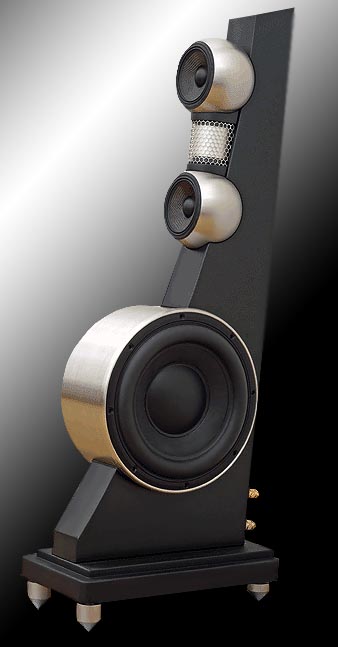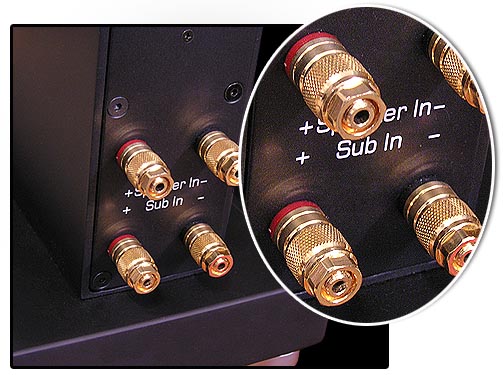|
|
|
|
|
This review page is supported in part by the sponsor whose ad is displayed above
|
|
 |
|
 |
|
|
|
|
 |
|
 |
|
|
|
Reviewer: John Potis
Analog Source: Rega P9 turntable, RB1000 & Hadcock GH Export arms, Benz Micro MC Silver, Rega Super Elys & Garrott Bros Optim FGS Cartridges
Digital Source: Accoustic Arts Drive1/Audio Aero Prima SE DAC
Preamp: Bel Canto Pre2P
Power Amp: Art Audio Carissa, Bel Canto e.One REF1000 monos, Canary CA 160 monos
Speakers: Hørning Perikles, Anthony Gallo Acoustics Reference 3.1, Ohm Acoustics Walsh4 with 4. mk.2 upgrade
Cables: JPS Labs Superconductor and Superconductor FX interconnects and speaker wire, Furutech Digi Reference digital
Power Cords: ZCable Heavys & Black Lightnings, JPS Power AC, Analog AC, Digital AC and Kaptovator power cords
Powerline conditioning: Balanced Power Technology 3.5 Signature Plus with ZCable Heavy power cord
Sundry accessories: Vibrapod Isolators and Cones, Ultra & Heavy ZSleeves, Viablue QTC spikes under speakers, Auric Illuminator
Room size: 12' by 16' with 9' ceiling
Review component retail: Reference 3.1 $2,995/pr; Reference S.A. bass amp $900
|
|
|
|
|
|
This is a review of the newly updated version of one of the most repeatedly and enthusiastically commented-upon speakers I've seen or read about in my 25+ years as a review-consuming audiophile. Few readers won't be familiar with the Gallo Reference 3 by now. It has accumulated more awards than any affordable speaker in memory. Srajan Ebaen, lord of these 6moons, was so moved by them that he actually created an entirely new award category just for them, the Lunar Eclipse. It's an award that readers can expect will be bestowed as often as its name implies. Well, in July of 2005, Anthony Gallo Acoustics started shipping an updated version dubbed the Ref 3.1, the details of which I'll get to in a moment.
While the Ref 3 became a relative overnight success, young audiophiles and readers may believe the same for their manufacturer, Anthony Gallo Acoustics. Almost nothing could be further from the truth. The accolades afforded the Gallo speaker line today are the product of years of science and exploration. Anthony Gallo was born in 1963 and claims that by 13, he had taken an intense interest in speaker design. By 14, he was experimenting with electrostatics. By then, he had discovered what most adult audiophiles already knew - that electrostatics offered a level of transparency and purity dynamic speakers could not. Experiments with ribbon drivers followed but those proved too limited in dynamic range.
Gallo's experience in speaker design was not all of the amateur/DIY sort. One of his earliest employment experiences was at Dahlquist, during its halcyon days as the manufacturer of the now classic DQ10 loudspeaker. Readers old enough to remember the DQ 10 may perceive a certain similarity between the baffle-less DQ 10 and the Ref 3.
|
|
|
|
|
 |
|
| In the early 80s, Gallo read a magazine article about Piezo film. The article was of no immediate use to him. Still, he claims that in the back of his mind, he knew already back |
|
then that he would work one day with this material. So he stowed the article away for a rainy day. By 1987, that article (and a lot of experimentation) produced the first CDT (cylindrical diaphragm transducer) tweeter. Voilà, Anthony Gallo Acoustics was born.
The first product off the drawing board was the original Nucleus loudspeaker, in a more conventional wooden cabinet design that weighed in at over 300lbs each. It was ultimately deemed too expensive and impractical for production. However, as with most all state-of-the-art designs, it served as a springboard for the future. In 1994, Gallo launched two loudspeakers, the Solo and the Reference. Like the Ref 3, these speakers were introduced with universal critical acclaim. In his treatment of the original Ref 3, Srajan recalled the lust he felt in his heart for those original Gallos back when they first launched. I too remember reading the reviews and lusting after them myself. However, due to their size and somewhat idiosyncratic styling, they met with somewhat less than stellar commercial success. By 1999, the Solo and the Reference ceased production and Gallo introduced the mighty little Micro system. It was to become Gallo's only commercially available product for the next five years. It was during that hiatus from the so-called High End that Anthony Gallo retreated to the drawing board. He used the sales of the Micro to fund an all-out redesign of the Solo and Reference. The goal was to meet or exceed their performance in a smaller and domestically more acceptable design.
|
|
 |
|
|
By 2004, Anthony Gallo returned with the introduction of the Ref 3. The rest is history. A refinement of the original CDT tweeter notwithstanding, the seed that bore the fruit of future designs was a new and patented technology called S2. Instrumental in the downsizing of Gallo's designs, S2 refers to a bagged polyolefin flake material that fills his speaker enclosures to control the woofer's Q at resonance. When a woofer is placed inside a small enclosure, its resonance frequency and Q tend to go up. S2 flattens that Q. Because the flakes weigh more than the air they replace and provide more surface area, they are said to indirectly couple to the cone at low frequencies and in turn trigger a mass-loading effect. In simple speak, S2 allows a smaller enclosure to behave like a much larger one - the driver "sees" more cubic air volume than is really present. This phenomenon permitted the downsizing of the larger spheres used in the original Reference and Solo loudspeakers. However, that's not where the advantages of S2 end. According to Gallo, the S2 flakes are also far more effective at blocking internal reflections from reemerging through the rear of the woofer cone than other fiberfill, be it natural wool or synthetic derivatives. There is, however, one disadvantage. You knew there had to be, didn't you? Any driver to be used in conjunction with S2 must be specifically designed to do so. Where S2 is concerned, Thiele-Small parameters don't completely apply.
|
|
 |
|
Some overnight success, huh? Less than three years after introduction of the Ref 3, Anthony's already returned to the drawing board to further refine what many have already called a giant killer. The main and most important differences between the old and the new version are as follows: The tweeter level control of the Ref 3 is gone. This is said to have improved high frequency micro dynamics as well as reliability. Gallo also replaced the non-polar electrolytic capacitor in the 1st-order series crossover with a metalized polypropylene equivalent said to eliminate a grayish coloration in the midrange as well as to enhance low-level information. Lastly, the midrange driver motor structure now utilizes a Neodymium magnet with an under-hung design. This allowed a shorter and lighter voice coil. According to Gallo, this reduced driver inductance and improved transient response as well as the upper midrange band for better integration with the tweeter. The smaller Neodymium magnet also increased air volume within the sphere and thus added lower midrange body.
If you feel as though you've read your fair share of Gallo Reference reviews, perhaps I can entice you into sticking around by including a discussion on Gallo's S.A. bass amplifier. Bass amplifier? Well, you did know that the woofers used in the Ref 3 and new Ref 3.1 utilize dual voice coils, no? On the rear of each speaker, two sets of binding posts are most assuredly not intended for biwiring but specialized bi-amping only. The top posts are routed to and through the entire speaker. The bottom posts connect solely to the woofer's second voice coil. When powered by a single conventional amplifier, the Ref 3.1's low-frequency limit is 34Hz. By sending a separate low-pass signal to the second voice coil with a little equalization via the bass amplifier, bass response is extended down to a subterranean 22 Hz - absolutely amazing bass extension for a speaker the size of the Ref 3.1.
|
|
| Yet power and extension aren't the only assets of the S.A. It also provides the same kind of bass-tuning flexibility you expect from most discrete subwoofers. You can use it to dial in the desired amount of active low-bass boost (maximum boost isn't always appropriate, particularly in small rooms). Should the room try to impose its will on the speakers' response, you can also adjust phase on the additional signal. Dual mono volume controls are provided, as is the option for stereo or mono operation. At the flip of a front-mounted switch, the S.A. bridges its 2 x 240 watts of power to 1 x 600, say to drive an outboard passive |
|
subwoofer for example. The S.A. also has front-panel adjustments to fix the low-pass filter frequency. Standard operating procedure suggests a 40Hz hand-over but since tastes and rooms are different, the user may find it beneficial to bump up the upper limit of the bass amp's influence to compensate for minor deviations in bass response at the listening chair. Suffering a little midbass suck-out? Adjust the low-pass filter upward and allow the S.A. to give the woofer a small shot higher up in the arm. A little midbass bloat instead? Adjust the low-pass frequency to that of the offending frequency and try tweaking the phase control just a touch this way or that. You can effectively trim out some of that bloat by partial cancellation. Are you starting to grasp the utility of this bass amplifier? I actually did exactly that to get me through a period of break-in on a new pair of amplifiers. Until they came to life, they were a little woolly in the bass. Naturally, I could have done the same to iron out a similar problem had it been room-induced.
|
|
| Like most subwoofer amplifiers, the S.A. provides for both low and high level inputs. You can drive it via speaker leads coming off your power amp (high level) or from your preamplifier output (low-level). I've been subwoofing for years now. During my earlier days, I felt more comfortable with the preamp level scheme. Since it removed the power amp from the signal chain, it just had to be the more optimal choice. Over the years, I've had a change of heart. Whenever possible, I now run the subwoofers from the main power amplifier. Why? Because as I swap amplifiers among three different brands I own plus whatever happens to be in for review, it's imperative that the subwoofer and speakers maintain relative polarity. If I use a power amp that inverts polarity and don't |
 |
|
| flip the speaker connections at the second voice coil, then the two parallel signals going to the same speakers will be out of phase. Using the output from the amplifier keeps the two legs of the speaker signal consistent no matter the amplifier in use. However, Gallo's S.A amplifier does offer one strong incentive to stick with its preamplifier inputs. When using those, the S.A. worked flawlessly and without a hitch. When using the high-level inputs, I did encounter one glitch. |
|
|
|
 |
|
 |
|
|
|
|
|
|
|
|
|
|
|
|
|
|
|